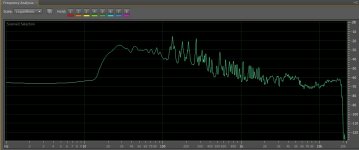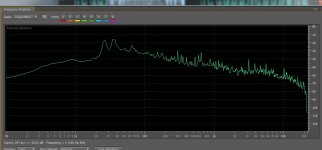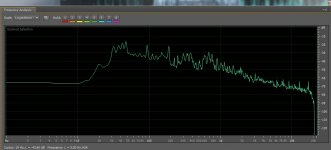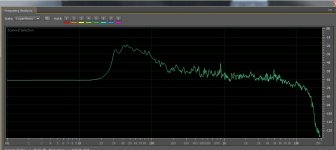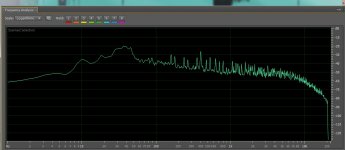So, we moved a year ago and I am now getting my system tweaked in. I was using JBL E140 woofers but they were terrible for home music.
I have JBL Barzilay cabs that I braced up really well. They ended up with an internal volume of 4.556 ft3. I just got my Lambda TD15X drivers yesterday. When I plug in everything into WinISD it shows an f3 at 40hz. That is with 2 4" ports each 9.5" long.
But I never took the time to fully understand how low I really need to go. The f6 is at 32hz but I can't seem to translate that in my mind to how strong the bass will be.
I have to wait a week before I can get to installing them and can't seem to stop my mind from wondering how they will sound. Tks, D.
I have JBL Barzilay cabs that I braced up really well. They ended up with an internal volume of 4.556 ft3. I just got my Lambda TD15X drivers yesterday. When I plug in everything into WinISD it shows an f3 at 40hz. That is with 2 4" ports each 9.5" long.
But I never took the time to fully understand how low I really need to go. The f6 is at 32hz but I can't seem to translate that in my mind to how strong the bass will be.
I have to wait a week before I can get to installing them and can't seem to stop my mind from wondering how they will sound. Tks, D.
I would think -6dB at around 30 Hz is pretty good. Keep it closer the wall and that would increase with room gain. You might need to experiment to make sure you don't get a big peak and cause the bass to boom.
Most music wouldn't have anything below 31 Hz I think. Some organ music does go down to 16 Hz or so but that's quite rare. I think -3db at 40 Hz would sound quite satisfying.
Most music wouldn't have anything below 31 Hz I think. Some organ music does go down to 16 Hz or so but that's quite rare. I think -3db at 40 Hz would sound quite satisfying.
An f3 at 40 Hz is quite reasonable. However, I prefer to have an f3 of around 30 Hz to better reproduce the full low-frequency sound spectrum that is contained in many recordings. I believe that the lowest note on a grand piano is at approximately 30 Hz, so an f3 at about that frequency would be attenuating the response somewhat. A grand piano is a relatively common instrument, so being able to reproduce its frequency spectrum faithfully seems to be a reasonable requirement for high-fidelity sound reproduction.
Ideally, I'd like to see an f3 of around 20 Hz or so in any high-fidelity speaker system. This generally necessitates the use of a subwoofer.
Ideally, I'd like to see an f3 of around 20 Hz or so in any high-fidelity speaker system. This generally necessitates the use of a subwoofer.
Last edited:
Ideally, my drivers want 8ft3 then tune / F3 of 31hz. Instead I put them both in 8ft3 and tune to 27hz. Sounds way better than 40hz tuning. Changes from bump bump to thump thump.
I like double 15's for Sade's "Somebody already broke my heart". It just sounds better, even at low volume, moving all that air, compared to an 8" that measures flat down to below 50hz.
Then again, I had some acoustat 11's. The 10" sealed bass module, while not loud at all, seemed to go deeeeeep.
Norman
I like double 15's for Sade's "Somebody already broke my heart". It just sounds better, even at low volume, moving all that air, compared to an 8" that measures flat down to below 50hz.
Then again, I had some acoustat 11's. The 10" sealed bass module, while not loud at all, seemed to go deeeeeep.
Norman
IMO, it really depends on what types of music you like. For myself, I have a fairly broad range of stuff I listen to. I can put my hands on at least a dozen discs in my collection which you'd be doing a disservice to if you didn't have subs that played right down to the low 20's, or lower if you listen to some types of electronica.
If you raise the threshold to tracks that dip below the "you only need to go down to 35 for music" claim I see quite a bit, that number inflates drastically.
If you raise the threshold to tracks that dip below the "you only need to go down to 35 for music" claim I see quite a bit, that number inflates drastically.
Thanks all. I also have a wide range of music and some of it has fairly beefy bass and sub bass. Since my box size and speaker placement is fixed, I think an adjustable port system will help with tuning the speakers to the room. I also have all the material to build 12 bass traps/reflection absorbers. I know my room has some suck out and boom boom points. I think making the panels first will benefit with tuning the speakers.
With most basses now having a fifth low B string (31 Hz compared to 40 Hz for a 4 string low E) 30 Hz response is missed once you hear it.
I'm using sealed subs in my living room, their response goes flat below 20 Hz.
My ported kitchen sub (Fb 40 Hz), though a bit louder, seems a bit lacking in LF response with much music by comparison.
I'd suggest lowering your box Fb to around 30 Hz (or even lower if you can stand the efficiency loss), there is quite a lot of musical content down to the 25 Hz range in pop music now.
I'm using sealed subs in my living room, their response goes flat below 20 Hz.
My ported kitchen sub (Fb 40 Hz), though a bit louder, seems a bit lacking in LF response with much music by comparison.
I'd suggest lowering your box Fb to around 30 Hz (or even lower if you can stand the efficiency loss), there is quite a lot of musical content down to the 25 Hz range in pop music now.
Bass drums and kettle drums benefit significantly from bass that is relatively flat down to 20 HZ. 40HZ is a minimum amount of extension in my opinion. Low bass has a lot of emotional impact, which I love. The trouble with ported boxes, besides the inconsistent damping over frequency, is that it's not wise to try to electronically force them to be flat to a lower frequency using an active EQ ahead of the poweramp. The damping becomes an issue, and the rolloff rate is pretty steep. To acoustically flatten a typical 12 inch woofer in a closed box to 20HZ requires about 20 dB of gain at 20HZ, relative to 100HZ. Closed boxes are smaller, and can be EQ'd however you want.
I listen to a wide variety of music. Jazz mostly I find goes into the 30's quite a bit. Even some folk music I thought was happy at 60, when I added a sub to my office I was surprised what was there. I would say 40 minimum, 30 better. About the only thing lower that that are special effects and heavy organ, which I don't listen to.
Djn,Hi Welter. how do I change the Fb (Enclosure resonance)? In WinISD, if I change the tuning freq for my box and driver, the response starts to roll off above 100hz.
The driver Fs remains the same regardless of Fb, Fb will remain the same with any driver put in the box.
To lower Fb, lengthen the port(s). Fb can also be lowered by putting an inner “Top Hat” on the existing port, a speaker cut out can be used, cut a port sized donut hole in the cut out and put it over the inner end of the port.
Rounding the port ends reduces chuffing.
Simulations often disagree with actual tunings.
The actual Fb can be determined by putting a white dot on the cone, and sweeping a sine wave tone through the speaker. The cone movement will be at minimum at Fb.
While it is not advantageous to use a Fb below Fs for PA use, acoustically small rooms provide LF “cabin gain”, so tuning lower than simulations may still provide a relatively flat LF response.
Art Welter
Thanks Art. I hear the term "room gain" or "cabin gain" a lot when discussion LF. Is that independent of room treatment like bass traps or absorption panels?
Also, I am thinking about using adjustable length tubes on the outside of the cabinet just for easy of adjustment. Does it matter if the port tube is outside or inside the cab?
Also, I am thinking about using adjustable length tubes on the outside of the cabinet just for easy of adjustment. Does it matter if the port tube is outside or inside the cab?
Might be a good idea to stick to a sealed box and eq it to get what you want. With a box placed near the wall room gain will lower the f3 frequency though you need to check this in your room. Moving the box around will change the lift due to room gain. You can alter the Linkwitz filter to get a curve to match your driver/box/room.
One way to get your room gain identified might be to get the free field response of a sealed sub ( small one might be OK ) and then place it where you desire in your room and get a response at your listening position. The difference would be the gain you can expect. You could then eq it the way you want.
One way to get your room gain identified might be to get the free field response of a sealed sub ( small one might be OK ) and then place it where you desire in your room and get a response at your listening position. The difference would be the gain you can expect. You could then eq it the way you want.
Thanks Art. I hear the term "room gain" or "cabin gain" a lot when discussion LF. Is that independent of room treatment like bass traps or absorption panels?
Hi,
In the room 'pressure zone' no but depends on the size of 'panel areas' and the effective BW to the total room area.
Bass traps can be effective in the room modal region: Acoustic Treatment and Design for Recording Studios and Listening Rooms
Also, I am thinking about using adjustable length tubes on the outside of the cabinet just for easy of adjustment. Does it matter if the port tube is outside or inside the cab?
That is practically the only way a Diy'r can figure out correct port lengts and yes it matters as the end correction factor depends on how the port is terminating.
For a simple BR box design:The trick here is to cut the lenght for a chosen Fb then recalculate or make the port somewhat shorter and test when flush to the baffle.It's an itreative procedure.
Important is also to check the large port signal behaviour as its very different from a small signal view.
b
After building a lot of boxes, I find with most music, tuning my ported boxes to around 35hz works best. I have an odd way of doing it. I select drivers and model the box to 27-30Hz, but shorten the port for a 35Hz tuning. This creates a bump in the range where the bass feels powerful, but not in the boomy range (70Hz+).
For sealed "hifi" designs, I select a driver with a low fs of around 20hz and put it in a box so the Qtc is around .7. This allows for a sealed design that can hit the low notes and has good extension.
For sealed "hifi" designs, I select a driver with a low fs of around 20hz and put it in a box so the Qtc is around .7. This allows for a sealed design that can hit the low notes and has good extension.
well, after looking into the linkwitz trans thing, a guy had better results with 1 driver with a passive radiator compared to 4 of the exact same drivers in a small box but eq'd. I think cone motion reduction is the key there.
I'm still tempted for an easy dual 15 push pull sealed box.
11ft3 = qtc .707 = F3 /fsb of 31hz
dayton rss390hf
That's deep for an un-augmented sealed.
Norman
I'm still tempted for an easy dual 15 push pull sealed box.
11ft3 = qtc .707 = F3 /fsb of 31hz
dayton rss390hf
That's deep for an un-augmented sealed.
Norman
After building a lot of boxes, I find with most music, tuning my ported boxes to around 35hz works best. I have an odd way of doing it. I select drivers and model the box to 27-30Hz, but shorten the port for a 35Hz tuning. This creates a bump in the range where the bass feels powerful, but not in the boomy range (70Hz+).
For sealed "hifi" designs, I select a driver with a low fs of around 20hz and put it in a box so the Qtc is around .7. This allows for a sealed design that can hit the low notes and has good extension.
1. Smart man with experience. +1
2. The ancient AR-3 was pretty flat on the curve going low but with a bit of boom around 37 Hz. Provided all the good quality bass you'd want and to this day, I can recall the delightful experience of hearing the organ pedals in St. Saens' 3rd Sym in 1967 (Munch, Boston??).
3. There always are trade-offs and choices. Going super-low is silly because there is almost no music down there and better to trade-off for smooth and clean curve (meaning you should use sealed boxes or OBs). Go for quality.
4. To answer your question, download free signal analysis software which will give a frequency analysis plot of your music as you play it. Do you see bumps at the bottom of the bass on your computer screen that your speakers aren't playing? Or, to tell the truth, do you see much of anything below 35 Hz?
5. I have dozens of organ CDs and they contain a few seconds of sound below 30... maybe. Even when your speakers don't play down there, your ears hear it anyway. As anybody ought to know. Granted, your sternum doesn't feel it.
B.
Last edited:
4. To answer your question, download free signal analysis software which will give a frequency analysis plot of your music as you play it. Do you see bumps at the bottom of the bass on your computer screen that your speakers aren't playing? Or, to tell the truth, do you see much of anything below 35 Hz?
This is why it's a tricky question. "much of anything below 35 hz" is an idea that audio guys have been lugging around for a long time because for many years, there really wasn't much down there except for organ music, which is why we see statements like this. "Well, if you're not listening to organ music..."
The truth is, in a lot of modern music, electronic in particular, we see tons of information below 35 hz. Sometimes, lots of it, and more as time goes on.
Just playing around for a few minutes, here's a few examples.
Attachments
- Status
- This old topic is closed. If you want to reopen this topic, contact a moderator using the "Report Post" button.
- Home
- Loudspeakers
- Subwoofers
- If I am not listening to movies, how low do I really have to go???
